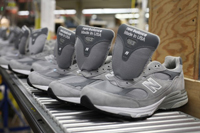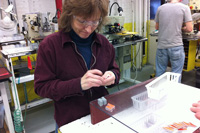New Balance Opposes Push to End U.S. Shoe Tariffs
Daily News Article — Posted on March 18, 2013
 (by Timothy Aeppel, The Wall Street Journal) – New Balance Athletic Shoe Inc., owned by former marathoner Jim Davis and his wife Ann, is the sole athletic-shoe maker that still has factories in the U.S. Those plants churn out about a quarter of the shoes it sells domestically. The rest are imported.
(by Timothy Aeppel, The Wall Street Journal) – New Balance Athletic Shoe Inc., owned by former marathoner Jim Davis and his wife Ann, is the sole athletic-shoe maker that still has factories in the U.S. Those plants churn out about a quarter of the shoes it sells domestically. The rest are imported.
The company has continued to make shoes in the U.S., even though that means settling for less profit. New Balance says the flexibility of its U.S. factories and turnaround times counted in days, rather than weeks, help make up for the higher cost. But a push by rivals to do away with tariffs on imported running shoes, as part of a larger trade deal, could finally tip the scales against its American strategy.
“A rapid reduction of the existing [tariff] agreements would put our factories here at significant risk,” says Robert DeMartini, CEO of the Boston-based company, which is fighting to keep the tariffs in place.
There’s a long tradition of American companies, including auto makers, fighting for trade barriers to fend off foreign competition. What’s unusual in New Balance’s case is that the same tariffs that benefit its U.S. plants boost the cost of the much larger share of the company’s shoes that are made outside the U.S.
Shoe tariffs have been around since the 1930s, when the U.S. still had a large domestic shoe industry that it wanted to protect from foreign competition. But today, the U.S. imports 99% of its shoes, mostly from Asia.
New Balance, with sales last year of $2.4 billion, views tariffs as one of several factors that keep its U.S. operations viable. The company has invested in new machines and cut out waste at its U.S. plants, which together employ 1,350 people. It also helps that the company’s American-made shoes tend to be pricey, retailing for as much as $275, and include designs first made popular decades ago that have been revived mainly as fashion accessories.
But even in its most streamlined form, shoe making remains relatively labor-intensive. The upshot, New Balance says, is that it still costs 25% to 35% more to produce shoes in the U.S. than it does in Asia.
Shoe tariffs, which vary widely depending on things like the materials involved, add about $3 to $5 to the cost of a pair of midprice imported running shoes. While that might not seem much, New Balance says the loss of that buffer would make the economics of its American-made strategy that much harder.
If the tariffs go away, “it puts our competitors in a position to realize an even greater margin than we are,” says Matthew LeBretton, a New Balance spokesman, “and they can then reinvest that in their business.”
The fight over tariffs comes as American manufacturing appears on the cusp of a revival, driven by forces expected to favor companies like New Balance. Wages in China have risen nearly 20% a year since 2007 – prompting many producers to shift labor-intensive work to lower-cost countries, such as Vietnam. But costs are rising in other parts of Asia, as well.
A recent study by the Boston Consulting Group (BCG) predicts that by 2015 there will be only about a 10% cost difference between China and the U.S. in making products such as machinery, furniture and plastics. But shoes aren’t among them.
Hal Sirkin, the BCG consultant behind the study, says too much labor is required to justify making all but the most-customized or expensive shoes in the U.S. “It’s unlikely you’ll see mass amounts of shoes made in the U.S. again,” he says, adding that even two years from now it will be 17% to 20% cheaper to make shoes in China than in the U.S. The cost advantage will be even greater in Vietnam, America’s second-largest shoe supplier.
Opponents of the tariffs say that the proposed trade deal would affect only a small share of U.S. shoe imports. That’s mostly because China isn’t one of the 10 other Pacific Rim nations, along with the U.S., that would be included in the deal. But the move would benefit Vietnam, which supplies just over 8% of America’s imported shoes.
Among those fighting the tariffs is New Balance rival Nike based in Beaverton, Ore. “Lower duties (taxes) would let us reinvest savings in innovation and in maintaining our global competitiveness, resulting in high-paying jobs in the U.S.,” says Greg Rossiter, a company spokesman. It would also help offset rising foreign labor and material costs.
Matt Priest, president of the Footwear Distributors and Retailers of America, an industry trade group, says cutting tariffs would set the stage for lower consumer prices. “There’s also a fairness issue,” he says. “We’re taxing Americans to protect jobs that are no longer here.”
………….
(NOTE: This article was first published at wsj.com on Feb. 27. Copyright 2013 Dow Jones & Company, Inc. All Rights Reserved. Reprinted here for educational purposes only. Visit the website at wsj.com.
Background
New Balance says its U.S. factories give it some advantages that help justify their higher costs. For instance, the company has developed a growing business in U.S.-made custom shoes. By going to the company's website, customers can order shoes in any combination of 26 colors of leather and five colors of fabric for nine different parts of a shoe. They also can order embroidered slogans. The custom shoes cost $115 a pair and can be delivered in four or five business days, which the company says would be impossible to do from Asia.
Mr. DeMartini, the CEO, says New Balance's U.S. plants—all of them in New England—also are "twice as productive" as any of the company's Asian shoe suppliers. "We learned a lot because we had to in order to survive."
The cachet of its pricey U.S.-made shoes at least partly accounts for New Balance's surprising success in exporting from the U.S. Last year, it sold almost 10% of its U.S. production - about 700,000 pairs of shoes - abroad, up 29% from two years earlier. One of its fastest-growing markets is China, where the company has 673 retail stores and plans to open 500 more this year.
"The type of shoes we make here [in the U.S.] are some of the most craft-dependent and least widget-like, with premium leather and hand stitching," says Mr. DeMartini.
To be sure, few companies are as committed to U.S. manufacturing as New Balance, which the Davises bought in 1972, but which traces its origins to 1906, when it started out as a maker of arch supports. At the company's plant in Norridgewock, Maine, a sign near the entrance reads in part: "We were brought up as a manufacturing company. It is our culture."
New Balance's factory in Skowhegan, Maine, is typical of its U.S. operations. Spread out over five floors, workers operate machines that cut and stitch fabric and leather. In one section, large automated stitching machines are embroidering the words "Made in USA" on shoe tongues. Many of the plant's 335 workers are refugees from other shoe companies that have closed in the region. (from the wsj article)

